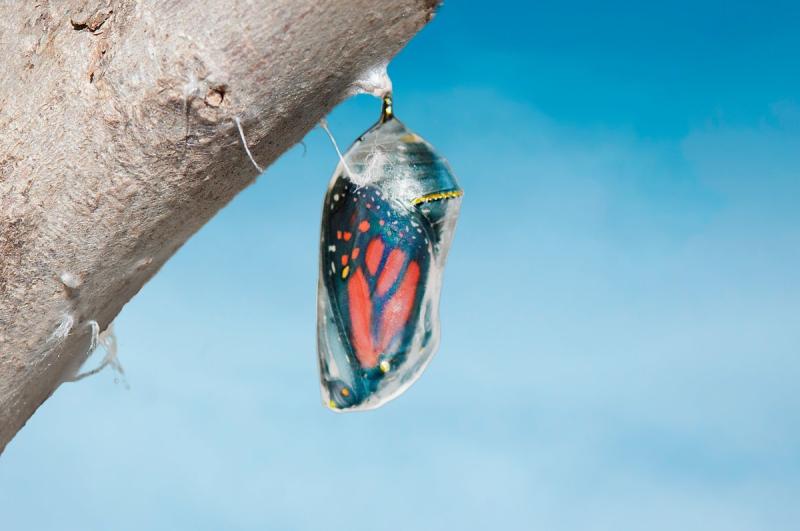How Does a Caterpillar Turn into a Butterfly?
By: Pocket




Photo by barbaraaaa / Getty Images .
As children, many of us learn about the wondrous process by which a caterpillar morphs into a butterfly. The story usually begins with a very hungry caterpillar hatching from an egg. The caterpillar, or what is more scientifically termed a larva, stuffs itself with leaves, growing plumper and longer through a series of molts in which it sheds its skin. One day, the caterpillar stops eating, hangs upside down from a twig or leaf and spins itself a silky cocoon or molts into a shiny chrysalis. Within its protective casing, the caterpillar radically transforms its body, eventually emerging as a butterfly or moth. But what does that radical transformation entail? How does a caterpillar rearrange itself into a butterfly? What happens inside a chrysalis or cocoon? First, the caterpillar digests itself, releasing enzymes to dissolve all of its tissues. If you were to cut open a cocoon or chrysalis at just the right time, caterpillar soup would ooze out. But the contents of the pupa are not entirely an amorphous mess. Certain highly organized groups of cells known as imaginal discs survive the digestive process. Before hatching, when a caterpillar is still developing inside its egg, it grows an imaginal disc for each of the adult body parts it will need as a mature butterfly or moth—discs for its eyes, for its wings, its legs and so on. In some species, these imaginal discs remain dormant throughout the caterpillar's life; in other species, the discs begin to take the shape of adult body parts even before the caterpillar forms a chrysalis or cocoon. Some caterpillars walk around with tiny rudimentary wings tucked inside their bodies, though you would never know it by looking at them. Once a caterpillar has disintegrated all of its tissues except for the imaginal discs, those discs use the protein-rich soup all around them to fuel the rapid cell division required to form the wings, antennae, legs, eyes, genitals and all the other features of an adult butterfly or moth. The imaginal disc for a fruit fly's wing, for example, might begin with only 50 cells and increase to more than 50,000 cells by the end of metamorphosis. Depending on the species, certain caterpillar muscles and sections of the nervous system are largely preserved in the adult butterfly. One study even suggests that moths remember what they learned in later stages of their lives as caterpillars. Getting a look at this metamorphosis as it happens is difficult; disturbing a caterpillar inside its cocoon or chrysalis risks botching the transformation. But Michael Cook, who maintains a fantastic website about silkworms, has some incredible photos of a Tussah silkmoth ( Antheraea penyi ) that failed to spin a cocoon. You can see the delicate, translucent jade wings, antennae and legs of a pupa that has not yet matured into an adult moth—a glimpse of what usually remains concealed.
Ferris Jabr is a contributing writer for Scientific American. He has also written for the New York Times Magazine, the New Yorker and Outside.
 Article is LOCKED by moderator [smarty_function_ntUser_get_name: user_id or profile_id parameter required]
Article is LOCKED by moderator [smarty_function_ntUser_get_name: user_id or profile_id parameter required]
Tags
Who is online
60 visitors


The absolute wonder of evolution.
Evolution is a mad scientist creating all sorts of ways for life to reproduce and grow to maturity: metamorphosis , eggs, seeds & pollination, Marsupialia pouches, live birth. ...
It really is fascinating; I am in constant awe at the many varied wonders of reality.
And sometimes an "evil" one. Think parasitoid wasps.
Now that's a miracle, cool article
What a wonderful article, much needed into today's world.
Ain't nature wonderful.
I was just filling bird baths and bird feeders and discovered a wasp nest in the lid of a bird feeder.
So I popped it out and laid it on the outside table, where miraculously it kept "rocking".
Brought it in the house and shined a flashlight in there and there are still 8 pulsating baby wasps in there looking back at us.
So I glued it to a dead vine out of the sun.
I might be able to get a picture but they are incredibly small in a clear cell shaped like a bullet.
Fascinating.
not a big fan of wasps. they had a tendency to access telecommunication junction boxes thru the drainage holes and build nests. easily perturbed. hard to run from them while standing on a ladder or telephone pole.
You can clearly see stripes and eyes on the two lower right ones.
Not sure if the pink one is a queen ? or a late developer.
At least in my small yards, my sainted wife calls me the wasp whisperer, especially out back.
I talk to them and give or take permission for where they start a 'nest'.
In the front yard when I'm feeding the ducks, I tend to attract butterflies.
I just planted some Lantana, supposed to attract butterflies.
I pulled the cover off a box once and got stung multiple times instantly. after that I carried a can of carburetor cleaner with a spray tube in the warm weather months. high ether content and the tube fit in the drainage holes. couple squirts of that and everybody was fast asleep when the cover came off.
I love the multi-color Lantana, they look like little bouquets.
Good thing about my climate is they come back every year.
I can't find any yet. Not surprised under the circumstances.
We are pretty sure about the gardens and the patio pots now as far as bulbs and perennials that are already up and blooming so it's time to replant the vacant spots and hope we don't hit any late bulbs.
Amazing.
Mother Nature is essentially the Sister of Mother Earth. Between the two of them, they do their best to provide a world that can sustain not only human life, but, the life of many other living organisms and creatures that share our world.
Mother Earth is the protector of Earth and all living things that dwell upon her. Mother Nature helps provide Mother Earth with the tools and resources to help do her part. Without the two of them working in cooperation with each other, there could be no lie here on Earth.
It is truly fascinating to see how they work together to provide that which mankind tends to take so much for granted.
The wonders of the world.
I am surprised no one had taken these discs and tried to implant them into other creatures.
Like some scary scifi stuff. Grow me some butterfly wings...